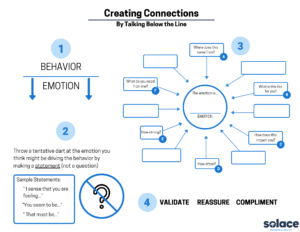The opposite of compulsion or addiction is connection
Talk “Below The Line” – In our communication with others, especially spouse and children, it is helpful to identify and discuss the emotions that promote about 90% of our behavior, rather than focusing entirely on visible behavior and audible communication that our loved ones use. Instead of asking “What’s wrong” or why are you so ticked off,” we can “talk below the line” by the following 3 steps:
- Throw a tentative dart at the emotion you think might be driving your loved one’s behavior and/or words, by saying; “you seem a little sad” or “it seems like you are upset.”
- This statement invites them to self-assess and functions as a very gentle invitation to talk about the emotion. If they validate or correct your stab at the emotion, and want to talk, then
- Continue to talk about that emotion with questions like “what is this like for you,” “what is causing this feeling,” “how strong is this,” “how often does this happen,” “how does this emotion affect your behavior,” or “what do you need from me?”
Click here [scan] to view, print, and/or share the handout;
“Creating Connection by Talking Below The Line”



